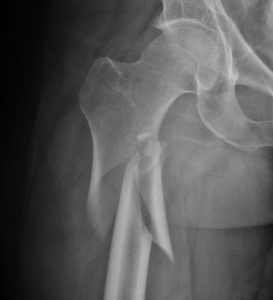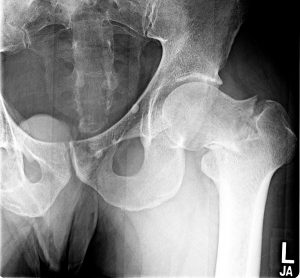Changing the Status-Quo of Osteoporosis Screening and Treatment

Osteoporosis fracture in a 48-year-old patient
Osteoporosis-related fractures are associated with costs reaching into the tens of billions of dollars annually in the United States. Many of these fractures may be prevented if at-risk patients received timely diagnosis and treatment. Specific treatment may include starting a pharmaceutical agent; calcium and vitamin D are good for healthy bone metabolism, but are not enough by themselves to stave off age-related and menopause-related bone loss. Yet, notes Edward J. Fox, MD, professor at Penn State Bone and Joint Institute, “Less than 25 percent of women who experience a fragility fracture receive any further workup for osteoporosis.” Fox and his colleagues are currently exploring ways to improve osteoporosis detection in this highly at-risk population.
In a study presented at the 2013 Orthopedic Research Society’s annual meeting1, women ages 50 years and older who presented at the Penn State Hershey emergency department (ED) with a low-energy fracture were randomly assigned to an intervention group, who received a follow-up letter within three months advising evaluation for osteoporosis, or a control group, who were contacted by telephone within three months of the ED visit, to determine whether they received any osteoporosis-related follow-up. Among women who received the intervention letter, 60.19 percent received followup osteoporosis evaluation; only 14.29 percent of the control group did so.

Osteoporosis fracture in a 78-year-old patient
Fox explains “Very few women in the control group had any osteoporosis testing after their fracture. These findings show that a simple, timely follow-up letter can significantly increase osteoporosis screening in high-risk patients.”
Other researchers have shown that telephone follow-up also can significantly increase the number of women who undergo osteoporosis testing. Given such promising results, Fox and colleagues will continue studying ways to further boost the followup rate. “We would like to see 90 percent or more follow-up among these patients, because, in time, they are very likely to experience another fracture.”
A second study is already underway, in which the effects of a combination letter and telephone intervention are being examined. Fox, however, explains “Ultimately, in any given community or region, it will take a physician to champion this cause and support the role of a care coordinator, who can take charge of follow-up.” Some organizations, like Kaiser-Permanente in California, have implemented bone care coordination with a high level of success, marked by significant reductions in fractures.
Fox says, “We know that simple interventions can work, but to close the gap between fracture and osteoporosis diagnosis and treatment, and improve care, physicians and health care systems must play a leadership role.”

Edward J. Fox, MD
Professor, orthopaedics and rehabilitation
Surgeon, orthopaedics and musculoskeletal oncology
Phone: 717-531-4816
Email: efox1@pennstatehealth.psu.edu
Fellowship: Musculoskeletal oncology surgery, Massachusetts General Hospital—Harvard Medical School, Boston, Massachusetts
Residency: Orthopaedic surgery and general surgery, Stony Brook University School of Medicine, Stony Brook, New York
Medical School: University of Rochester School of Medicine and Dentistry, Rochester, New York
Connect with Edward J. Fox, MD, on Doximity
Reference
- Varacallo, MA, Fox, EJ, Hassenbein, SE, et al. Evaluation of patient’s response toward intervention automated osteoporosis intervention program. Poster presented at: Orthopaedic Research Society Annual meeting, San Antonio, TX, January 26-29, 2013.
